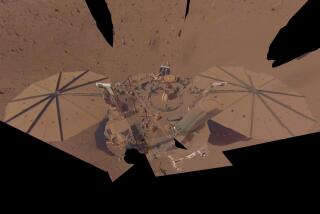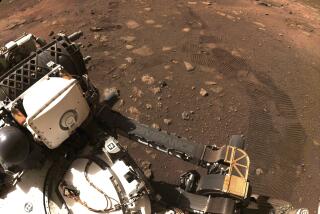NASA’s InSight mission will look deep into the heart of Mars for clues about its past
- Share via
For decades, earthlings have dispatched spacecraft to Mars to study the planet’s dusty surface and its thin atmosphere. Now NASA is sending a lander to the red planet to look deep into its heart.
As early as Saturday morning, NASA’s InSight will blast off from Vandenberg Air Force Base in California. After a nearly seven-month journey, it will begin probing the deep interior of a nearby world that once may have looked much more like our own.
The Interior Exploration using Seismic Investigations, Geodesy and Heat Transport mission aims to understand the hidden heat flow of the planet, its seismic activity and the nature of its core. All of these could help scientists delve into the history and evolution of our planetary neighbor.
“Even though we’ve had a lot of missions to Mars — orbiters and also landers and rovers crawling around on the surface — we’ve never had a mission that was devoted to looking inside Mars,” said Gerald Schubert, a geophysicist and planetary physicist at UCLA who is not involved in the mission. “InSight’s really unique in exploring the internal structure and composition of the terrestrial planets. There’s never really been one like this before.”
NASA has sent seismometers to Mars before, aboard the two Viking landers that touched down in 1976. But those didn’t work as planned — the instrument on Viking 1 failed, and the one on Viking 2 was overwhelmed by vibrations from the Martian winds. (The last time NASA seismometers were successfully deployed off Earth was during the Apollo missions to the moon.)
Bruce Banerdt remembers those Viking failures all too well. A graduate student in geological sciences at the time, he felt a pang of dismay when it became clear the sensors wouldn’t produce much, if any, seismological data.
Now Banerdt is a geophysicist at the Jet Propulsion Laboratory in La Cañada Flintridge and the principal investigator for InSight. With a new generation of Martian seismometers ready for launch, “I can hardly even sleep at night, I’m so excited,” he said. “It’s been such a long path.”
Rovers, landers and orbiting spacecraft have found evidence of lakes, rivers, volcanoes and life-friendly chemical combinations on Mars. Seismology allows scientists to glimpse the internal machinations that led to those features.
“With seismology, we can basically put together a 3D map of the inside of the planet,” Banerdt said. “From that we can start to understand how the planet was formed, how it works.”
Billions of years ago, scientists think, Mars looked much more like Earth: It had water lakes and perhaps even a shallow ocean under puffy clouds that floated in a thick atmosphere. Tests conducted by the Curiosity rover have shown that microbial life could theoretically have existed in an environment such as this.
Then the planet’s interior cooled and Mars lost most of its atmosphere. Without it, the water evaporated and the surface became the rusty, dusty expanse we see today.
Studying Mars’ internal dynamics will help scientists learn why it evolved the way it did, Banerdt said.
For example, Earth has a protective magnetic field that prevents our atmosphere from being stripped away by the solar wind and cosmic rays. That field is powered by the movement of molten metal in Earth’s core.
Mars appears to have lost its magnetic shield early in its history, and the planet’s atmosphere today is about 100 times thinner than Earth’s. Studying the Martian core could help researchers understand why Mars’ fate diverged from our own.
On a rocky planet like Mars, the heat coming from the interior today is largely produced by radioactive elements, said Sue Smrekar, a JPL geophysicist and InSight’s deputy principal investigator. That heat would have powered Martian volcanoes and other geophysical reactions, ultimately producing the planet’s atmosphere and at least some of its liquid water.
Knowing things like where the atmosphere came from, what was in it and how long it lasted could help scientists estimate how long Mars hosted life-friendly environments. And knowing the concentrations of radiogenic elements inside Mars will help scientists figure out how much energy was available to fuel all of this activity, Smrekar said.
”That helps us better understand the original building blocks of the planet,” she said.
Once InSight lands on Mars in late November, it will act as a solar-paneled doctor, using its three main instruments to take the planet’s temperature, check its reflexes and perform a sonogram.
The craft will place a seismometer on the surface of the planet and then cover it with a protective shield to damp out the wind and thermal ”noise” on the surface. This seismometer will listen for marsquakes — the Martian version of earthquakes — as well as meteorite strikes.
Both produce seismic waves that are altered in different ways as they pass through the planet’s layers of material. The farther away these perturbations originate the better, because the waves will pass through more material and sample deeper portions of the planet before reaching the seismometer. Studying the subtle modifications to those waves will reveal a clearer picture of Mars’ contents.
InSight will also deploy a heat flow probe to get a better sense of the planet’s internal temperature, hammering it about 16 feet deep to avoid the influence of the day-night swings on the surface. The changes it detects should help scientists determine how hot Mars’ interior is.
Finally, the spacecraft will measure the shift in radio signals between it and Earth to see how much the Martian north pole wobbles as the planet revolves around the sun. That wobble’s size and frequency could offer hints about the diameter and density of the planet’s core.
While scientists have made educated guesses about how the Martian interior looks, they still don’t know for sure what they’ll find, said Sean Solomon, a seismologist and planetary scientist at Columbia University who was the principal investigator for NASA’s 2011 MESSENGER mission to Mercury.
“Much of what we understand about seismic records from the Earth may not apply when we go to another planetary body,” said Solomon, who is not involved in InSight.
That’s a good thing, scientists say.
Each of the rocky planets in our solar system — particularly Venus, Earth and Mars — are made of roughly the same stuff and formed in roughly the same solar environment. But subtle differences in factors such as their size, composition and distance from the sun led each planet to look very different from its neighbors.
In that way, each one serves as a separate run of a natural experiment that can teach us about planets in general, Solomon said.
“Someday we will be sending spacecraft to the nearest star with planets, but in the meantime we’re limited to what astronomical observations can be made,” he said. “So the deeper we understand our solar system neighbors, the better position we will be in to interpret what we can measure from exoplanets.”
Follow @aminawrite on Twitter for more science news and “like” Los Angeles Times Science & Health on Facebook.
MORE IN SCIENCE
A pileup of 14 distant galaxies is set to become the most massive structure in the universe
NASA is about to step up its planet-hunting game with the launch of TESS
A search for some of Earth’s most extreme creatures in the West Coast’s deepest underwater canyon







